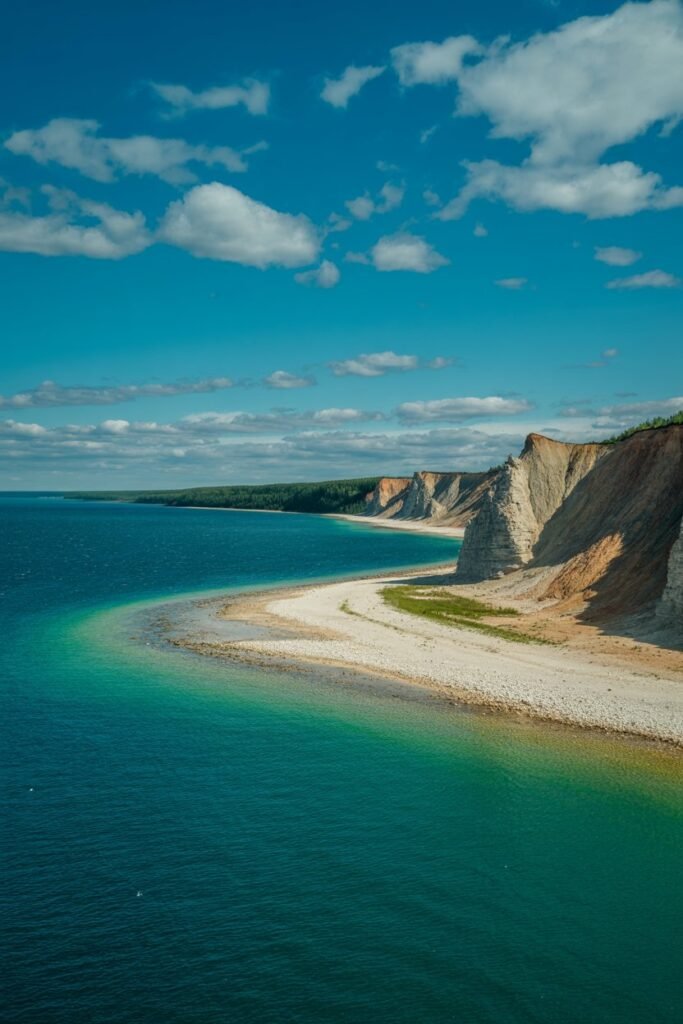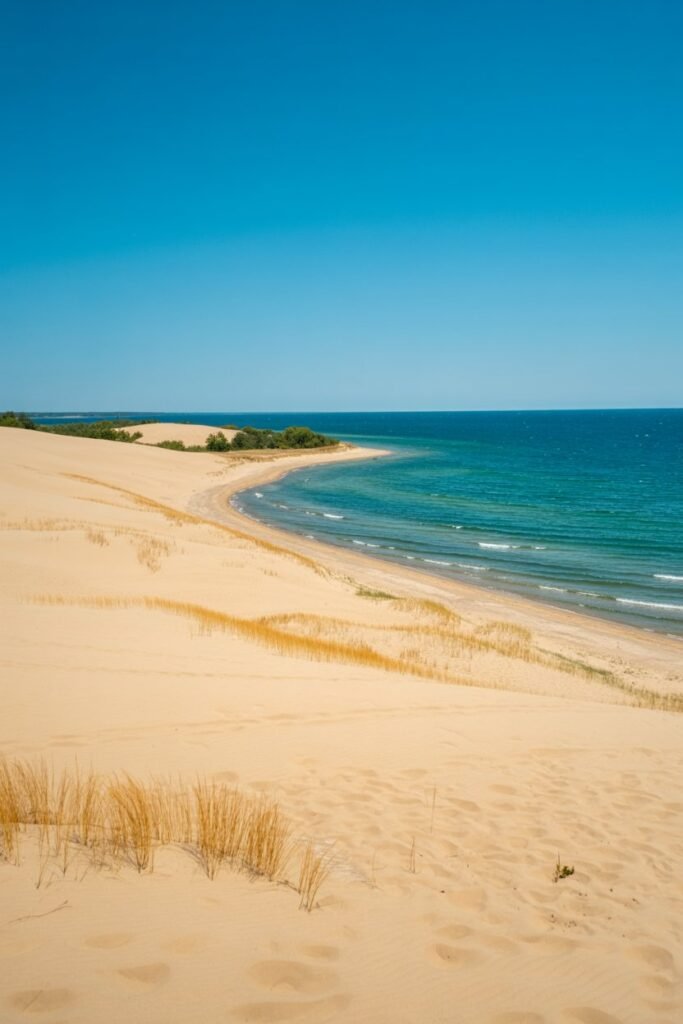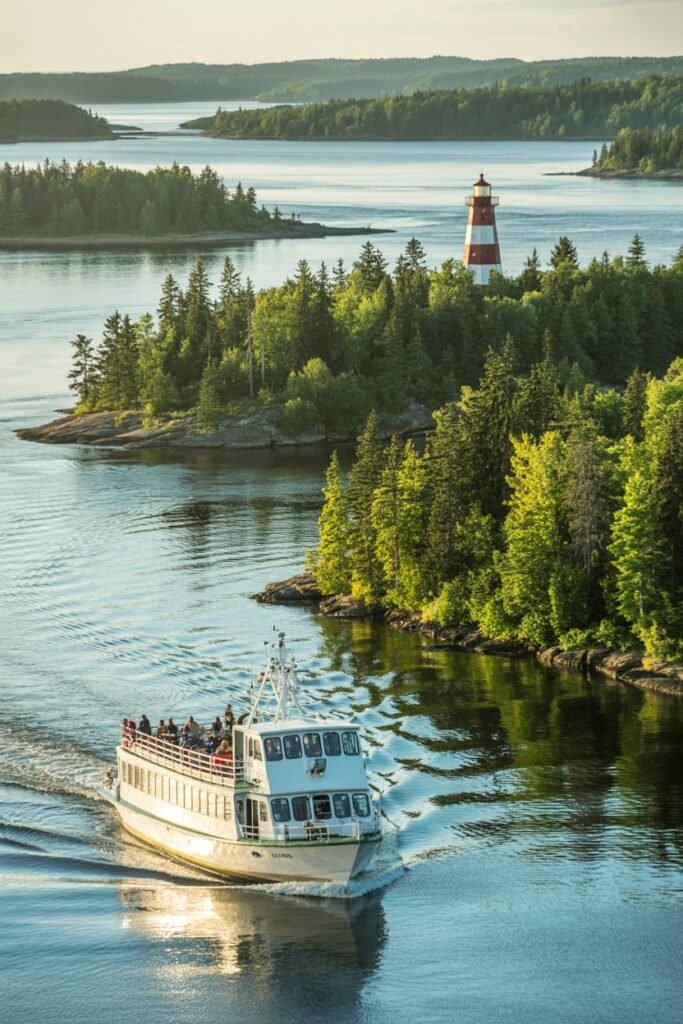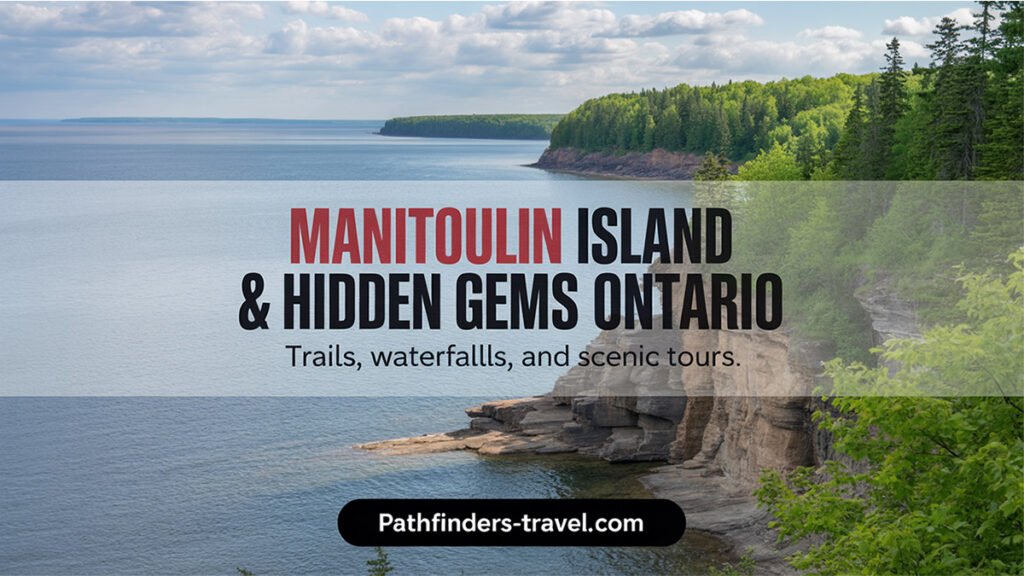Estimated reading time: 15 minutes
Key Takeaways
- Manitoulin Island is the world’s largest freshwater island, covering 2,766 km² within Lake Huron
- The island features unique natural attractions, including the Cup and Saucer Trail and Whitefish Falls
- Indigenous culture is prominent, with six Anishinaabe First Nations communities offering cultural experiences
- Sandbanks Provincial Park showcases the world’s largest freshwater sand dune system
- A trip to Ontario can be combined with Thousand Islands boat tours from Kingston for a complete experience
Table of Contents
- Introduction
- Discovering Manitoulin Island
- Exploring Whitefish Falls on Manitoulin
- Visiting Sandbanks Provincial Park
- Thousand Islands Boat Tours from Kingston
- Itinerary & Practical Information
- Frequently Asked Questions about Ontario’s Great Lake Islands
- Conclusion
Introduction
Introduction to Ontario’s Hidden Islands and Parks
Ontario boasts some of the most diverse natural landscapes in Canada, from pristine lakes and sandy beaches to vibrant forests and dramatic shorelines. Among these wonders are hidden destinations that promise adventure away from the crowds. Manitoulin Island stands out as a remarkable gem, known for its natural beauty and cultural heritage among Ontario’s getaways. As the world’s largest freshwater island, Manitoulin offers a perfect blend of cultural and natural allure that makes it truly special.
While planning your Ontario adventure, consider including other exceptional experiences such as Thousand Islands boat tours from Kingston or spending a day at Sandbanks Provincial Park. These destinations showcase the incredible variety of landscapes that make Ontario’s hidden gems so appealing to nature lovers and cultural explorers alike.
Want to see this for yourself? Click here to jump to the video in UHD 4K Resolution.
Discovering Manitoulin Island: Geography, Culture, and Trails
Significance and Geography
Manitoulin Island has earned its place in geography books as the world’s largest freshwater island, covering an impressive 2,766 km² within the vast waters of Lake Huron [SOURCE]. What makes this island particularly fascinating is its unique geological feature – it contains over 100 lakes itself, some with their own islands. The most notable is Treasure Island, which holds the distinction of being the largest island-in-a-lake-on-an-island-in-a-lake in the world [SOURCE]. This remarkable island-inception showcases Manitoulin’s status as a natural wonder.
Natural Features and Scenic Landscapes
The landscape of Manitoulin Island presents a captivating tapestry of rolling hills, crystal-clear lakes, hidden swimming holes, scenic beaches, and lush forests. These diverse environments create perfect conditions for hiking, cycling, fishing, and wildlife viewing [SOURCE]. Among the many natural attractions, the Cup and Saucer Trail stands as the crown jewel for hikers. Rising to the island’s highest point at 351 meters above sea level, this trail offers panoramic views over West Bay and Lake Manitou that simply take your breath away [SOURCE].
The island’s shoreline varies dramatically, from rocky outcrops to sandy beaches, providing countless spots to enjoy the pristine waters of Lake Huron. Many visitors come to simply relax by the water, while others take advantage of the excellent fishing opportunities in the many inland lakes.

Local History, Indigenous Influences, and Culture
The rich history of Manitoulin Island is deeply rooted in Indigenous heritage. The name “Manitoulin” comes from the Ojibwe term “Manidoowaaling,” meaning “Cave of the Spirit,” and locals often refer to it as “Spirit Island”. Archaeological findings suggest human occupation dating back an astonishing 12,000 years [SOURCE].
Today, six Anishinaabe First Nations call the island home, each offering unique cultural experiences. Visitors can participate in traditional Pow Wows or explore the Ojibwe Cultural Foundation in M’Chigeeng to learn about indigenous art, language, and traditions. European settlement later added another layer to the island’s cultural fabric, creating picturesque small towns like Gore Bay and Kagawong, where museums chronicle the island’s marine and logging history [SOURCE].
Exploring Whitefish Falls on Manitoulin Island: Access, Hiking, and Photography
Introduction to Whitefish Falls
Whitefish Falls represents one of Manitoulin Island’s most captivating natural attractions. This cascading water feature is set amidst rugged limestone formations and surrounded by lush forested areas [SOURCE]. The falls create a striking visual as water tumbles over the rock ledges, making it a focal point for nature photographers and outdoor enthusiasts visiting the island.
The sound of rushing water combined with the natural beauty of the surrounding landscape creates a peaceful atmosphere that invites visitors to pause and appreciate the raw power of nature. Many travelers consider Whitefish Falls a highlight of their Manitoulin Island experience.

How to Reach and Explore
Located south of the town of Whitefish Falls, this natural wonder is easily accessible via Highway 6 when traveling between Espanola and Little Current. Visitors typically park in a designated area and take a short walk to reach the falls. The path is generally well-maintained, making it accessible for most fitness levels.
The best times to visit are late spring to early summer when water flow reaches its peak following the winter melt. Autumn also offers a special experience with fewer crowds and the beautiful backdrop of fall colors reflecting in the water. If photography is your goal, morning light provides the best conditions for capturing the dynamic movement of the falls.
Photography, Hiking, and Nearby Attractions
For photography enthusiasts, Whitefish Falls offers numerous vantage points to capture its beauty. The contrast between the white water and the surrounding rock formations creates striking images, particularly in the soft light of early morning. Consider using a polarizing filter to cut glare from the water surface and a tripod for longer exposures that create that silky water effect.
Hiking trails around the area provide additional opportunities to enjoy the natural beauty, with paths offering views of the La Cloche Mountains and river valleys. While exploring the region around Whitefish Falls, make time to visit Ten Mile Point, which offers spectacular sunrise and sunset vistas over Georgian Bay and the La Cloche mountains. The Ten Mile Point Trading Post is worth a stop to browse local arts and crafts created by island artisans.
Visiting Sandbanks Provincial Park in Prince Edward County
Introduction to Sandbanks Provincial Park
Sandbanks Provincial Park near Picton offers visitors a chance to experience one of Ontario’s most unique natural formations. The park boasts the largest freshwater sand dune system in the world, creating a landscape that seems more fitting for an ocean coastline than a lake shore. These impressive dunes formed over thousands of years as glacial sediments were deposited and shaped by wind and water.
The park features three expansive beaches – Sandbanks, Outlet, and Dunes – each offering soft golden sands, gentle swimming conditions, and dramatic dune backdrops that create perfect settings for exploration and photography. The contrast between the blue waters of Lake Ontario and the golden sand creates a striking visual that draws visitors from across the province and beyond.

Key Features and Activities
Visitors to Sandbanks can enjoy a wide range of recreational activities throughout the year. Swimming is particularly popular during summer months when the shallow waters warm up quickly. The gradual slope of the beaches makes them family-friendly and suitable for waders of all ages.
Hiking across the dunes provides another way to experience this unique ecosystem. Marked trails guide visitors through the dune environment while helping to protect sensitive vegetation. Birdwatching opportunities abound, with the park serving as home to numerous shorebird species. The rare dune ecosystem supports unique plant and animal species that have adapted to this specialized environment.
For those who prefer water activities, canoeing and kayaking along the shoreline offer different perspectives of the dunes. Fishing is permitted in designated areas, with several fish species inhabiting the waters around the park.
Practical Advice
Accommodations at Sandbanks Provincial Park range from basic campsites to more comfortable options in nearby Prince Edward County. The park offers over 500 campsites, many with electrical hookups, but these fill quickly during peak season. Reservations are strongly recommended, especially for summer weekends and holidays.
If camping isn’t your style, numerous B&Bs and hotels in the area provide comfortable alternatives. The nearby towns of Picton, Bloomfield, and Wellington offer charming accommodations within a short drive of the park.
Visitors should note that the park can become extremely busy during summer months, particularly on weekends. Arriving early in the day helps secure parking and beach space. Picnicking is allowed in designated areas, but visitors must follow all park regulations to help protect the sensitive dune environment. Bring plenty of water, sun protection, and appropriate footwear for walking on sand.
Thousand Islands Boat Tours from Kingston on the St. Lawrence River
Kingston as a Gateway
Kingston stands as a fascinating historical city where Lake Ontario meets the St. Lawrence River. With its beautifully preserved 19th-century limestone architecture and vibrant waterfront, Kingston serves as the perfect gateway for exploring the natural wonders beyond its shores. The city’s strategic location has shaped its development from a military stronghold to a hub for water-based adventures.
Before embarking on a boat tour, take time to explore Kingston’s downtown area. The city briefly served as Canada’s capital in the 1840s, and many buildings from that era remain intact. Fort Henry, a UNESCO World Heritage Site, offers insights into the region’s military history. The bustling market square hosts local vendors selling fresh produce, crafts, and prepared foods – perfect for gathering picnic supplies before heading out on the water.
Boat Tour Experience
A Thousand Islands boat tour provides one of the most memorable ways to experience this unique archipelago. As the vessel navigates through the St. Lawrence River, passengers are treated to views of picturesque inlets, historic lighthouses, and notable islands dotting the waterway. The archipelago consists of over 1,800 islands straddling the border between Canada and the United States, creating a maze of channels and passageways.

Standard tours typically last between 1-3 hours, with narration providing historical context and interesting facts about landmarks along the route. You’ll pass by Heart Island, home to the famous Boldt Castle, and Millionaire’s Row, where wealthy industrialists built summer mansions during the Gilded Age. Many tour boats include glass-bottomed sections for underwater viewing or upper decks that provide panoramic vistas of the surrounding landscape.
The best time for these tours runs from late spring through early autumn when the weather is pleasant. Sunset cruises offer particularly magical experiences as the fading light casts golden hues across the water and island silhouettes.
Booking Tips and Kingston Attractions
For the best experience on a Thousand Islands boat tour, book your tickets in advance, especially during peak summer months. Many operators offer online reservations with discounts for early booking. Tour boats typically depart from Kingston’s downtown waterfront, making them easily accessible for visitors staying in the city center.
When selecting a tour, consider your interests. Some focus on natural history and wildlife, while others emphasize the region’s architectural landmarks or smuggling legends from the Prohibition era. Family-friendly options might include activities for children, while adults might prefer tours that include meals or beverages.
While in Kingston, complement your boat tour with visits to other local attractions. The Pump House Steam Museum offers insights into the city’s industrial past, while the Agnes Etherington Art Centre showcases fine art collections. For dining, Kingston’s waterfront restaurants serve fresh seafood with views of the harbor – the perfect way to end a day of exploration before heading to other unseen Canadian destinations.
Itinerary & Practical Travel Information for Ontario’s Lake Regions
Sample Itinerary
This 7-10 day itinerary connects all the locations discussed in this guide to visiting Manitoulin Island and surrounding attractions:
- Days 1-2: Kingston and Thousand Islands
- Arrive in Kingston and explore the historic downtown
- Take a morning Thousand Islands boat tour
- Visit Fort Henry and enjoy Kingston’s waterfront dining
- Days 3-4: Sandbanks Provincial Park
- Drive to Prince Edward County (approximately 1.5 hours from Kingston)
- Spend a full day exploring the sand dunes and beaches
- Visit local wineries in Prince Edward County
- Day 5: Travel Day
- Drive north toward Manitoulin Island (approximately a 5-hour drive)
- Consider an overnight stop in Sudbury if needed
- Days 6-8: Manitoulin Island
- Explore the Cup and Saucer Trail for panoramic views
- Visit Whitefish Falls and Ten Mile Point
- Experience indigenous cultural centers in M’Chigeeng
- Explore the towns of Gore Bay and Kagawong
- Days 9-10: Return Journey
- Take the MS Chi-Cheemaun ferry from South Baymouth to Tobermory
- Explore Bruce Peninsula National Park if time allows
- Return to starting point or continue to Niagara Falls
This itinerary allows for flexibility based on your interests and available time. You can extend stays at any location or add additional stops along the route.
Travel Tips
Transportation: Renting a car provides the most flexibility for this itinerary. Public transportation options are limited, particularly for reaching Manitoulin Island. If traveling to Manitoulin, you have two main options: drive across the Little Current Swing Bridge from the north, or take the MS Chi-Cheemaun ferry from Tobermory to South Baymouth during its operating season (May-October) [SOURCE].
Accommodations: Book accommodations well in advance, especially for summer visits. Options on Manitoulin Island range from:
- Campgrounds (both provincial parks and private)
- Bed and Breakfasts in small communities
- Lodges and small hotels in Gore Bay and Little Current
- Cottage rentals for longer stays
Best Times to Visit: Late spring to early fall (May-September) offers the warmest temperatures and best access to outdoor activities. Each season provides unique experiences:
- Spring (May-June): Fewer crowds, waterfalls at peak flow, spring wildflowers
- Summer (July-August): Warmest temperatures, all attractions open, busiest period
- Fall (September-October): Spectacular fall colors, fewer visitors, cooler temperatures
- Winter (November-April): Limited services on Manitoulin, but beautiful snowy landscapes for those prepared for winter conditions
Insider Tips:
- Bring insect repellent for forest hikes, especially in early summer
- Reserve ferry tickets in advance during peak season
- Fill your gas tank whenever possible as stations can be far apart on Manitoulin
- Bring good hiking shoes for exploring trails
- Check park websites for current conditions and seasonal events
- Mobile phone coverage can be spotty in remote areas – download maps in advance
Frequently Asked Questions about Ontario’s Great Lake Islands and Travel Planning
When is the best season to visit Manitoulin Island and Ontario’s Great Lake Islands for weather, services, and fewer crowds?
The best season to visit is late spring through early fall (roughly May to September), which balances pleasant weather, open services, and lighter visitor numbers. July and August are busiest, while late September offers colourful foliage with fewer crowds.
How can travelers get around Manitoulin Island and reach nearby Great Lakes attractions?
Travelers can reach Manitoulin Island by driving across the Little Current Swing Bridge or taking the MS Chi-Cheemaun ferry from Tobermory during its operating season. Once there, a car is essential for exploring island attractions and nearby destinations due to limited public transport.
What budget should I plan for when visiting Manitoulin Island, Thousand Islands, and Sandbanks Provincial Park?
Travel budgets vary by season, type of accommodation, transportation, and activities. Camping and small inns help reduce costs, while peak-season trips with ferries, fuel, and lodging can run several hundred Canadian dollars for a multi-day visit.
What safety and practical tips should visitors know when traveling Ontario’s Great Lake Islands?
Visitors should prepare for mosquitoes and blackflies in early summer, rapid weather changes near the lakes, and patchy mobile service in remote areas. Sturdy footwear, layered clothing, and checking ferry or bridge schedules in advance are recommended.
How many days are needed to explore Manitoulin Island and Ontario’s nearby hidden gems?
Plan around 7–10 days for a complete itinerary that includes Thousand Islands, Sandbanks, and several days on Manitoulin Island. Shorter trips can focus on specific highlights such as the Cup and Saucer Trail, Whitefish Falls, or Kingston’s waterfront.
Conclusion
Ontario’s Great Lake regions combine striking natural features with deep cultural roots. From the expansive freshwater landscapes of Manitoulin Island to the quiet charm of Whitefish Falls, and from the sweeping dunes of Sandbanks to the island labyrinth of the St. Lawrence, each destination offers its own perspective on the province’s diverse environments.
Travelers can enjoy a balance of outdoor recreation, heritage learning, and quiet reflection. Indigenous cultural centres, historic towns, and scenic hiking trails enrich visits beyond their visual beauty, creating opportunities to connect with Ontario’s layered history and communities.
Planning with the seasons in mind is essential, as each time of year reshapes the experience—from spring waterfalls and wildflowers to autumn colours and lighter crowds. Routes that link Kingston, Prince Edward County, and Manitoulin Island form a logical circuit for first-time visitors seeking variety in a single journey.
For further inspiration on extending your trip, see our Ontario hidden gems travel guide, which highlights additional parks and cultural stops across the province.
Share your experiences or favorite Ontario destinations in the comments below, and check out more travel guides for additional inspiration. For stunning visuals of these incredible locations, visit Pathfinders Travel on YouTube to watch Wonders of the World Travel Documentaries in 4K resolution.


